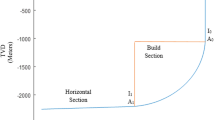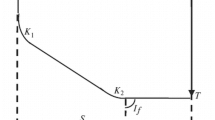Abstract
For decades, the slide drilling system (SDS) has played a critical role in the area of directional drilling. Drilling in the sliding mode is much more time-consuming than drilling in the rotating mode for a SDS. Therefore, it generally takes more time to drill a curved wellbore segment than a straight segment of the same length. Based on this fact, a novel wellbore trajectory design for SDSs is proposed in this paper to reduce the total drilling time and improve economy. The basic idea of our strategy is to replace a long curved wellbore section, e.g., the build-up and drop-off sections, with a series of short circular-arc and straight-line segments in the design stage. Assuming that rotating and sliding modes are only used for straight-line and circular-arc segments, respectively, the total drilling time is reduced by increasing the average rate of penetration. Therefore, the problem lies in how to replace a long circular arc with multiple short circular arcs and straight lines to minimize the total drilling time, which is the aim of this research. In this paper, a piecewise trial strategy is proposed, where the optimized wellbore trajectory is generated by adding circular-arc and straight-line segments with equal length one by one according to the “line first” principle. This strategy converts the original optimization problem, which involves both combinatorial and parameter optimization of unknown dimension, to a much easier one, where there are only three design variables and one set of constraint equations. Due to the multimodal characteristics of the objective function, genetic algorithm (GA) is adopted to obtain the optimal solution. A great reduction of the drilling time is obtained by applying our method to two typical cases, which shows a clear potential for future field applications.









Similar content being viewed by others
References
Alali A, Barton SP, et al. (2011) Unique axial oscillation tool enhances performance of directional tools in extended reach applications. In: Brasil Offshore, Society of Petroleum Engineers
Altamimi IM, Mokrani S, Zulkaf AH, et al. (2015) Axial oscillation tool significantly mitigates the vibration level and enhances drilling performance in conjunction with standard rss systems. In: Abu Dhabi International Petroleum Exhibition and Conference, Society of Petroleum Engineers
Amorin R, Broni-Bediako E (2010) Application of minimum curvature method to wellpath calculations. Res J Appl Sci Eng Technol 2(7):679–686
António CC (2006) A hierarchical genetic algorithm with age structure for multimodal optimal design of hybrid composites. Struct Multidiscip Optim 31(4):280–294
Arora J, Elwakeil O, Chahande A, Hsieh C (1995) Global optimization methods for engineering applications: a review. Struct Optim 9(3-4):137–159
Aroztegui M, Herskovits J, Roche JR, Bazán E (2014) A feasible direction interior point algorithm for nonlinear semidefinite programming. Struct Multidiscip Optim 50(6):1019–1035
Atashnezhad A, Wood DA, Fereidounpour A, Khosravanian R (2014) Designing and optimizing deviated wellbore trajectories using novel particle swarm algorithms. J Natural Gas Sci Eng 21:1184–1204
Bagirov AM, Karasözen B, Sezer M (2008) Discrete gradient method: derivative-free method for nonsmooth optimization. J Optim Theory Appl 137(2):317–334
Bessaou M, Siarry P (2001) A genetic algorithm with real-value coding to optimize multimodal continuous functions. Struct Multidiscip Optim 23(1):63–74
Bourgoyne AT, Millheim KK, Chenevert ME, Young FS (1986) Applied drilling engineering, Society of Petroleum Engineers. Richardson, TX
Branch MA, Grace A (1996) MATLAB: optimization toolbox: user’s guide, MathWorks
Chen K-D, Chen J-Q, Hong D-F, Zhong X-Y, Cheng Z-B, Lu Q-H, Liu J-P, Zhao Z-H, Ren G-X (2019) Efficient and high-fidelity steering ability prediction of a slender drilling assembly. Acta Mech 230(11):3963–3988
Deb K (2000) An efficient constraint handling method for genetic algorithms. Comput Methods Appl Mech Eng 186(2-4):311–338
Gillan C, Boone S, Kostiuk G, Schlembach C, Pinto J, LeBlanc MG, et al. (2009) Applying precision drill pipe rotation and oscillation to slide drilling problems. In: SPE/IADC Drilling Conference and Exhibition, Society of Petroleum Engineers
Gillan C, Boone SG, Leblanc MG, Picard RP, Fox RT (2011) Applying computer based precision drill pipe rotation and oscillation to automate slide drilling steering control. In: Canadian Unconventional Resources Conference, Society of Petroleum Engineers
Goldberg DE (1989) Genetic algorithms in search, optimization, and machine learning. Addison Wesley
Goldberg DE, Deb K (1991) A comparative analysis of selection schemes used in genetic algorithms. In: Foundations of genetic algorithms, vol 1. Elsevier, pp 69–93
Hajela P, Lin C-Y (1992) Genetic search strategies in multicriterion optimal design. Struct Optim 4(2):99–107
Hanea R, Casanova P, Wilschut FH, Fonseca R (2017) Well trajectory optimization constrained to structural uncertainties. In: SPE Reservoir Simulation Conference, Society of Petroleum Engineers
Herskovits J, Santos G (1997) On the computer implementation of feasible direction interior point algorithms for nonlinear optimization. Struct Optim 14(2-3):165–172
Lentsch D, Savvatis A, Schubert A, Schoebel W (2012) Overcoming drilling challenges with rotary steerable technology in deep geothermal wells in the molasse basin of southern germany. GRC Transactions 36:165–169
Liang Y, Leung K-S (2011) Genetic algorithm with adaptive elitist-population strategies for multimodal function optimization. Appl Soft Comput 11(2):2017–2034
Liu X (2006) The geometry of wellbore trajectory, Beijing: Petroleum Industry Press
Liu J. -P., Cheng Z. -B., Ren G. -X. (2018) An arbitrary Lagrangian–Eulerian formulation of a geometrically exact timoshenko beam running through a tube. Acta Mech 229(8):3161–3188
Lozano M, Herrera F, Cano JR (2008) Replacement strategies to preserve useful diversity in steady-state genetic algorithms. Inform Sci 178(23):4421–4433
Maidla E, Haci M, Jones S, Cluchey M, Alexander M, Warren T, et al. (2005) Field proof of the new sliding technology for directional drilling. In: SPE/IADC Drilling Conference, Society of Petroleum Engineers
Maidla EE, Haci M, Wright D, et al. (2009) Case history summary: horizontal drilling performance improvement due to torque rocking on 800 horizontal land wells drilled for unconventional gas resources. In: SPE Annual Technical Conference and Exhibition, Society of Petroleum Engineers
Maidla E, Haci M, et al. (2004) Understanding torque: the key to slide-drilling directional wells. In: IADC/SPE Drilling Conference, Society of Petroleum Engineers
Martinez J, Carson CR, Canuel LA, Burnett TG, Gee R, et al. (2013) New technology enables rigs with limited pump pressure capacity to utilize the latest friction reduction technology. In: SPE Eastern Regional Meeting, Society of Petroleum Engineers
Mitchell M (1998) An introduction to genetic algorithms. MIT Press
Sawaryn SJ, Thorogood JL (2003) A compendium of directional calculations based on the minimum curvature method. In: SPE Annual Technical Conference and Exhibition, Society of Petroleum Engineers
Sheng Z, Gonglin Y, Zengru C (2018) A new adaptive trust region algorithm for optimization problems. Acta Math Sci 38(2):479–496
Shokir E. E. -M., Emera M, Eid S, Wally A (2004) A new optimization model for 3D well design. Oil & Gas Science and Technology 59(3):255–266
Simon D (2013) Evolutionary optimization algorithms: biologically-inspired and population-based approaches to computer intelligence. Wiley
Skyles L, Amiraslani Y, Wilhoit J, et al. (2012) Converting static friction to kinetic friction to drill further and faster in directional holes. In: IADC/SPE Drilling Conference and Exhibition, Society of Petroleum Engineers
Steihaug T (1983) The conjugate gradient method and trust regions in large scale optimization. SIAM J Numer Anal 20(3):626–637
Taylor HL, Mason MC (1972) A systematic approach to well surveying calculations. Soc Pet Eng J 12(6):474–488
Wang Z, Gao D, Liu J (2016) Multi-objective sidetracking horizontal well trajectory optimization in cluster wells based on ds algorithm. J Pet Sci Eng 147:771–778
Warren TM (2006) Steerable motors hold their own against rotary steerable systems. In: SPE Annual Technical Conference and Exhibition, Society of Petroleum Engineers
Wilson G (1968) An improved method for computing directional surveys. J Petrol Tech 20 (8):871–876
Yu G, Zhao Y, Wei Z (2007) A descent nonlinear conjugate gradient method for large-scale unconstrained optimization. Appl Math Comput 187(2):636–643
Zhong X-Y, Liu J-P, Lu Q-H, Cheng Z-B (2019) An adaptive toolface control method for slide steering drilling. Acta Automatica Sinica 45(6):1044–1054
Funding
This research was financially supported by the National Major Science and Technology Project of China (Grant No. 2016ZX05025-002), National Key R&D Program of China (Grant No. 2017YFC0307100), and the National Basic Research Program of China (Grant No. 2015CB251203); their support is highly appreciated.
Author information
Authors and Affiliations
Corresponding author
Ethics declarations
Conflict of interest
The authors declare that they have no conflict of interest.
Additional information
Responsible Editor: Emilio Carlos Nelli Silva
Publisher’s note
Springer Nature remains neutral with regard to jurisdictional claims in published maps and institutional affiliations.
Replication of results
The results described in this paper can be replicated by implementing the formulas and MATLAB programs in this paper. The authors would like to share the program code, which can be used for commercial purposes with the consent of the author.
Electronic supplementary material
Below is the link to the electronic supplementary material.
Rights and permissions
About this article
Cite this article
Zhong, XY., Liu, JP., Chen, KD. et al. A time-optimal wellbore trajectory design for slide drilling systems. Struct Multidisc Optim 63, 881–896 (2021). https://doi.org/10.1007/s00158-020-02732-y
Received:
Revised:
Accepted:
Published:
Issue Date:
DOI: https://doi.org/10.1007/s00158-020-02732-y




